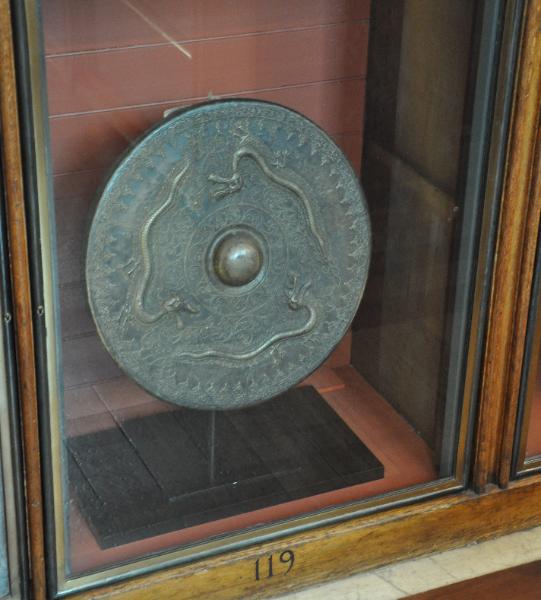
Brunei Brass Dragon Gong
Large Brass Gong (Tawak-tawak)
Sarawak (Malaysia) or Brunei
early 20th century or earlier
diameter: 50cm, width: 16cm
This gong or tawak-tawak is typical of brasswork from Sarawak or Brunei on the island of Borneo. Cast using the lost wax process, it is elaborately decorated on the face with dragons and a variety of sea creatures including crabs and fish, and on the wide rim with crocodiles and fish. The particularly prominent central boss and wide rim are typical of Malay gongs compared with Thai and Burmese gongs that are flatter and more shallow.
The elaborate decoration on this gong compares with Malay brassware from peninsular Malaysia which on the whole is far more utilitarian, subdued and in keeping with Islamic prohibitions on figurative art.
Tawak-tawak once were used as signal gongs to call people together. They tended not to be used as part of a gamelan orchestra as in nearby Indonesia. Gong smiths, like kris smiths, worked in an atmosphere of magic and incantation. Some gongs were believed to be protected by supernatural beings (Singh, 1985). Such gongs were also used in barter trade – as a store of wealth and as a form of currency.
Extant examples of old brassware from Brunei and elsewhere on the island of Borneo frequently exhibit strong Chinese influence such as dragons despite Islam being Brunei’s main religion today.
Children’s stories that are still told in Brunei and Borneo feature tales of Chinese princes and dragons. One tells of a dragon that lives atop Mount Kinabalu (Borneo’s highest mountain) where it guards a magnificent precious stone the size of a peacock’s egg. The Emperor of China hears about the stone and tells his three sons that whichever one of them brings back the stone will be made his heir; the other two will be killed. One son manages to trick the dragon and captures the stone. But the other sons lie to their father that they were the ones to take the stone. Ultimately, the Emperor discovers this deception and the wayward sons escape China, one of whom returns to Brunei and founds a princely dynasty there.
A gong of similar form is in the collection of the National Museum of Singapore. And click
here
to see a similar example in the British Museum.
References
the National Museum of Singapore gong is illustrated in Singh, B.,
Malay Brassware, National Museum of Singapore, 1985, p. 40
Inventory no.: 431
Ask about this item
here
.




A tawak-tawak gong of similar form currently displayed in the British Museum.

Another example in Malaysia’s National Museum. (Photographed February 2017).

